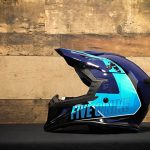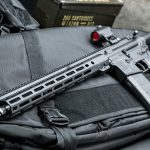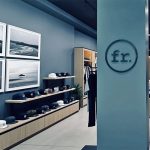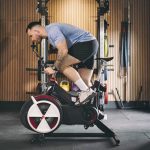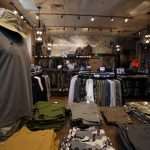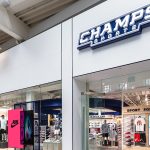In its biggest overhaul since changing its name from “Modell's Shoppers World” in the late 1980s to focus solely on sporting goods, Modell's Sporting Goods last week launched a comprehensive reinvention initiative entitled “Rebirth.” Prototypes that opened in Pelham and Bay Plaza in the Bronx include “category shops” that sell key sports from top to bottom, revamped footwear departments eliminating the display wall, and much clearer signage to provide shoppers a virtually unhindered view across the selling floor.
Speaking to around 120 vendors as well as bankers, licensing partners and real estate partners at a presentation at Yankees Stadium, company President Seth Horowitz said Rebirth can be summed up by a statement from CEO Mitchell Modell: “The Rebirth project will be our statement to the world that we are no longer an apparel company that happens to carry sporting goods but rather a sporting goods company that carries apparel.”
In particular, Horowitz said the project that has so far spanned 18 months is designed to better capitalize on Modell's position as the “local” destination for sporting goods while also improving its ability to deliver a “convenient and compelling” shopper experience to consumers. The Yankee Stadium setting was designed to underscore the extent of the changes.
“This does not mean we're going to move one gondola of sporting goods and change the front of the store and call it a day,” said Horowitz. “Rebirth is a process of cultural change and a massive undertaking for the organization. It's cultural in making, which are the tougher changes to affect.”
The project also reflects feedback from extensive research, including 24 focus groups, 12,000 consumer surveys by e-mail and accompanying 200 shoppers in shopping trips. The goal was to better understand the “psychographics” of Modell's' customer and learn exactly how they shop the store.
Among the key findings was that its largest sales, profit and brand opportunity “is in executing sporting goods in the eyes of the consumer.” Horowitz called it the broadest category “where we let [customers] down most often.” Sporting goods includes on-field apparel. The second insight from the research was that executing a local merchandising strategy and offering convenience was “not only a distinguishing positioning but a reason why shoppers would shop our stores” over competitors.
Third, research showed that its MVP customers, which make up over 60% of the business, perceived that licensed products made up 60% to 80% of sales when it accounts for 15% to 20%. While that demonstrated the chain's strength in sports licensing, it also pointed to opportunities for other categories.
“When you walked our stores in Boston the day after the Celtics won the championship, there was no doubt that they won the championship. It's like a big celebration,” said Horowitz. “But when little league season starts, the store looks the same. When soccer season starts, the store looks the same. So we have to take some of our best executions in terms of store presentation around licensed product and execute them across other meaningful time periods for our customers through the year.”
The fourth learning from the research was that women make up 60% of Modell's customers. Horowitz said the industry sometimes goes as high as 55% women's/45% men's and Modell's is around 70% men's/30% women's. This underscored a “tremendous opportunity” in selling to women, he said. At the same time, Modell's recognized that 70% of its MVP customers have children under the age of 15. That likewise underscored the importance of catering to kids and moms at the store level.
Finally, the last key learning was that clutter was the number one reason that shoppers didn't shop Modell's. In further probing survey respondents, clutter not only meant excessive product across racks or aisles, but signage and other “virtual noise when the customer walks the store.”
In order to plot the Rebirth strategy, Modell's created a 13,500 square foot store in its distribution center in the Bronx complete with fixtures and branded shops to experiment with new formats. The 13,000 to 20,000 size range of Modell's stores presents challenges in stocking and presentation when competing against big boxes that can be double to quadruple the size. But Horowitz also noted that the variety of the spaces Modell's operates particularly necessitated the mock shop.
“We need to plan every rack, every footwear bunker and every sporting goods gondola,” said Horowitz. “We need to execute space planning like it has not been executed in sporting goods before because we have 144 different boxes. Some are three levels. Some are two levels. Some have little left hand turns. Some have little right hand turns. That's the beauty of what we're able to do in real estate because we're one of the few retail operators that can do that. So we needed an environment where we could set the foundation on how we're going to plan our stores, both our effectual fixturing and our POP.”
Among the changes in the new prototype are the creations of “categorical shops” around five statement sports: baseball, football, soccer, lacrosse and training. Said Horowitz, “We will service everything above the foot in those shops. So in soccer it will be apparel, shin guards, soccer balls, socks, sack packs. And then we will highlight footwear in our soccer shops and drive people to the back wall.”
The statement shops also won't move throughout the year as Modell's research found that women in particular “hate when stores move things. They want to come in, know exactly where they want to go, then they want to get out and say, 'See you later!,' ” said Horowitz.
By comparison, older units have one big sporting goods area encompassing multiple sports and leave consumers frustrated looking for merchandise.
The statement shops also won't move throughout the year as Modell's research found that women in particular “hate when stores move things. They want to come in, know exactly where they want to go, then they want to get out and say, 'See you later!,' ” said Horowitz.
By comparison, older units have one big sporting goods area encompassing multiple sports and leave consumers frustrated looking for merchandise.
In footwear, Modell's is simplifying the presentation. research showed that customers did not know what was on the wall and what was in the bunkers, partly because different retailers train customers to shop the category in different ways. Management was “shocked” to discover that some customers only shopped the bunkers and assumed the same product was on the display wall, which includes better offerings. As a result, Modell's is utilizing the footwear back wall for selling instead of for display. For higher-end exclusives or limited-edition merchandise, a section on the wall was created with signs “very clearly called out” to urge customers to ask associates for assistance on those items.
Modell's is also creating two distinct segments for selling footwear. The first, men's, is categorically built around themes such as running, basketball, training and cleats.
It has two drive aisles as Horowitz noted that “seating is extremely important, especially for family shopping.” One drive aisle will focus on running nine months out of the year, and basketball for three. The other will focus on cleats for nine months, and outdoor boots for three.
Meanwhile, women's and kids’ footwear will be moved closer to the middle of the store and next to their respective apparel sections. “Convenience is extremely important for the customer shopping in both of those areas,” said Horowitz. A three-month test of this realignment in five stores delivered a 35% jump in women's and kid's footwear versus the rest of the chain.
Meanwhile, women's and kids’ footwear will be moved closer to the middle of the store and next to their respective apparel sections. “Convenience is extremely important for the customer shopping in both of those areas,” said Horowitz. A three-month test of this realignment in five stores delivered a 35% jump in women's and kid's footwear versus the rest of the chain.
Each store will also have a licensed fan zone that includes men's, women's and kid's product together as well as licensed hard goods. Research showed that customers found it “very confusing” when licensed kids was in the kid's area and licensed women's was in women's.
Vendor shops will also be a primary focus around brands such as Under Armour, Nike, Adidas, New Era, The North Face and Dickies. The North Face has been in limited distribution at the chain for the last twelve months but the Pelham location was the first in-store shop for the brand. To help drive women's sales, a particular emphasis in building each shop was to correlate a prominent women's fixture to each entrance “to drive the customer's eyes to see women's activewear when she walks in the store.”
A “Mo's Zone” featuring time-sensitive product, such as little league items at the start of the season as well as hot markets such as big Yankees wins, will be featured at the store front. Formerly, this area was called “the red zone,” but “Mo's Zone” is less cluttered and called out more.
For in-store creative and navigational signage, the prototype features more red band directional signage to call out categories such as baseball. “The days of having a sign over our sporting goods gondola that says ‘sporting goods’ is over,” said Horowitz. “That definitely is not helping mom or dad find baseball, soccer, lacrosse or football.” The company also studied navigational signage at retailers such as Target, Whole Foods and Best Buy to improve sight lines so shoppers can easily spot categories from anywhere in the store.
“When a customer is shopping sporting goods they're also shopping those retailers so they're looking for a better experience,” said Horowitz. “They can't get it in sporting goods so we are gong to deliver it.”
The stores will also use the color yellow less often than before to highlight deals as Horowitz noted that a “sea of yellow” often undermined sales efforts. Clipboards are also being added around the stores to explain product features and benefits to reinforce Modell's expertise in advising customers on what to buy.
Ultimately, according to Horowitz, the new store presentation is designed to create “Holy %#&@!” reaction with consumers within the sporting goods space.
“We're not pretending to be anybody that we're not,” said Horowitz. “We don’t' want to be as big and beautiful as other retailers. We want to execute local family sporting goods, convenient and compelling for the athlete and fan in all of us and it’s the driving factor behind every single one of our decisions. And I will tell you the first time we went through this and took our associates to our DC, there were many 'Holy %#&@s!'“
Changes are also planned around customer service.
Modell's is working “relentlessly internally” to eliminate in-store tasks to keep associates focused on customers. Associates are also being encouraged to ask, “What can I do to help you today?” with an emphasis on the time element of “today.” They are being urged to walk customers to product after research showed that doing so raises the average ticket by 60%. Explaining features and benefits are also being stressed.
Finally, associates are being urged to say “Thank you for shopping with us” to further instill its local, family positioning. Toward the same goal, Modell's is looking for further drive grassroots marketing and capitalize on Team Weeks, its donation program for local teams.
Modell's logo is also being simplified with its birth year “1889” and the “Your Hometown Sporting Goods Store” line removed. A marketing campaign around the conversions is being planned for next spring with the “Gotta Go to Mo's” slogan continuing to play a major role.
With all the changes, Horowitz said Modell's still needs to deliver deals and maintain its value proposition.
“It's a critical part of the element of Modell's,” said Horowitz. “As a local family sporting goods store, the customer has to trust us that we will have the best prices in the market. We cannot be undersold or you lose the customer.”
With two store conversion completed, the goal is to have key elements of the new prototype “touch” over 100 more by February 26, 2010, which is the kickoff of the baseball season. Modell's also plans to open four to six stores over the next 12 months in the northeast.
Modell's has also cut back on inventories and expenses amid the downturn. But Horowitz noted that “you can manage yourself right outside of your business” if all investment in the future is abandoned.
“I'm not saying it's time to be wild and spend,” said Horowitz. “But there is a time when you have to stop the bleeding and start to invest where you know the decision is going to have a return on your investment and we're at that place at Modell's Sporting Goods.”
Mitchell Modell echoed his sentiments, “You can't go backward. You need to invest.”


